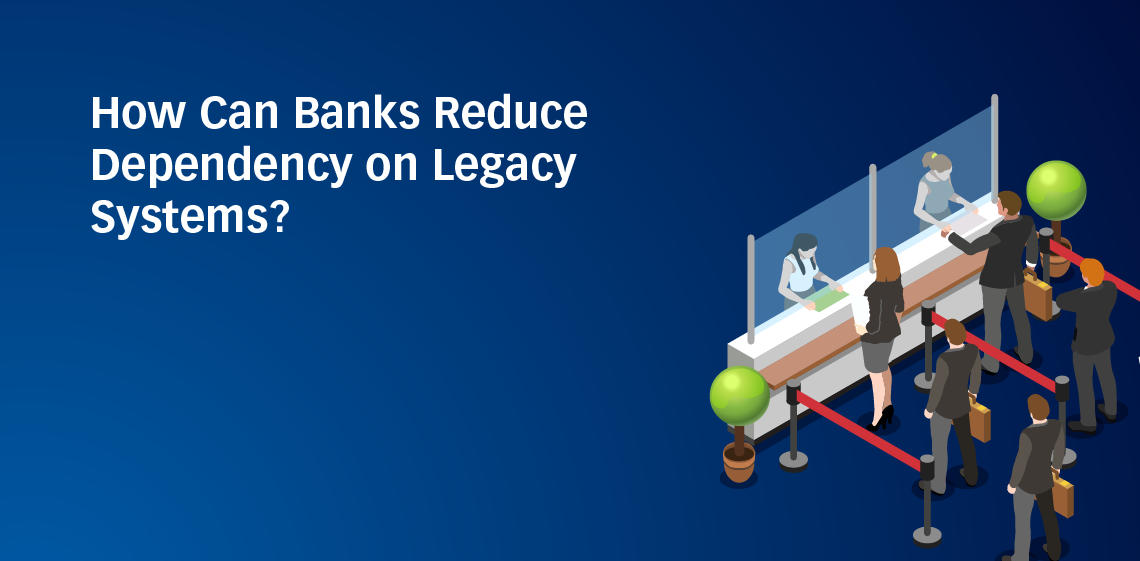
June 16, 2021
How Can Banks Reduce Dependency on Legacy Systems?

Most financial institutions and service providers have their own mature systems that have been running their day-to-day operations perfectly for years. Today however, these systems are more problematic than beneficial due to their outdated technology, high maintenance and support costs, as well as their limitations on seamlessly addressing new market needs, business requirements, and regulatory mandates.
These systems are none other than legacy systems, or legacy applications, which are defined by Gartner as “information systems that may be based on outdated technologies but are critical to day-to-day operations.” The definition is indeed accurate as the main challenges financial institutions have been encountering are the required time, costs, efforts and risks associated with modernizing legacy systems, especially if they are critical core systems.
Undoubtedly, the rise of the fintech industry and rapid evolution of digital services presented new challenges and added pressure on financial institutions to also rapidly improve their services to retain their customers’ and business teams’ demands; in other words, sustain their business in what has become a highly competitive market. This improvement, however, is much easier said than done.
Many financial institutions already started modernizing their legacy systems, while others are still in the evaluation and planning phase. In general, where financial institutions stand with their legacy systems today depends on the systems they have in place, business scales, services catalogue and complexity of their internal business operations.
In all cases, some common questions by financial institutions in this modernization journey include how much has it cost us until today? How much more time and costs will it need? Will the new modernized system become outdated in a few years because of continued changes in technology, business natures and market needs?
All these questions are viable. How can financial institutions secure an acceptable return on investment in modernizing legacy systems? Put more simply, how can financial institutions reduce dependency on their legacy systems and accelerate digital transformation?
During the past decade, technology companies and solution providers attempted different approaches to find the optimal balance between attaining the benefits of current legacy systems, which include their rich business heritage and stability over the years, and transforming financial services, which include building user-friendly and fully digital customer experiences across omni-channels.
Business Process Modeling
During the last decade, institutions started considering Business Process Modeling (BPM) as part of their legacy system transformation program. The approach presented new challenges including the need to revisit the institution’s entire processes and activities in place to build a clear services catalogue, then breakdown the result into activities which can be mapped into small components that can be exposed to front-end systems and integrated with legacy systems. The rationale behind this approach was that each new process is now contained into an external layer of integration between the legacy system and digital modernized systems.
Service-Oriented Architecture to Microservices Architecture
Introducing Service-Oriented Architecture (SOA) into financial solutions’ design was one of the first approaches in migrating legacy systems into more modernized ones. The natural evolution of this technology however, led to a more robust and flexible technology known as Microservices Architecture.
Microservices architecture served enhancing the features originally introduced by SOA, and with the evolvement of cloud computing in the past decade, it is now somewhat becoming a de-facto standard for migrating legacy systems into cloud-native infrastructure.
Ultimately, a new approach was introduced to accommodate for new trends based on cloud hosting and cloud-based infrastructure. The new microservices architecture enables institutions to build an independent communication layer between microservices that is one-to-one, or through an event bus that facilitates the orchestration of end-to-end transactions. The event bus became especially important when institutions started considering back-end legacy services as microservices by themselves and integrating them with the new digital modernized systems.
This approach has resulted in enabling financial institutions to maintain their investment in their legacy systems, while allowing them to seamlessly migrate to new modernized systems, apply service digitization gradually and attend to business needs without hindering normal business operations.
In addition, it allows financial institutions to continuously evaluate, analyze and improve their new digital services for enhanced customer satisfaction and time-to-market through Continuous Integration and Continuous Delivery (CI/CD) that facilitate gradual rollout of services.
At ProgressSoft, we followed the microservices architecture approach through introducing a set of solutions that act as middle digital transformation layers at financial institutions; starting from the newly launched Digital Banking Platform to the universal Payments Hub; all of which are based on a microservices architecture with rich sets of Application Programming Interfaces (APIs) that facilitate smooth integration and modernization with minimal to zero changes and costs on legacy systems.
So when should financial institutions migrate a process/service from their legacy systems?
Modernization of legacy systems and digital transformation journeys at financial institutions are not short-term, or short-earn, initiatives. They consist of multiple phases which are based on each institution’s individualistic strategy, roadmap and what they consider as Minimum Viable Products (MVPs). During program execution, business processes and the nature of services will continue to change according to market needs or internal business requirements.
Therefore, we always recommend that financial institutions avoid new investments in legacy systems to address these changes. Instead, the newly introduced end-to-end services should be either maintained within a microservices orchestrating platform that is integrated with legacy systems, or fully migrated to the new platform leaving legacy systems for simple transactions recording and general ledger entries.
We found that with this recommendation, financial institutions minimize their dependency on legacy systems and encourage their internal teams to accelerate digitizing services all while mitigating the time, costs and risks associated with the process. It also provides the needed flexibility to retire legacy systems as new functional specific services can now fulfill all their internal and external business needs.



